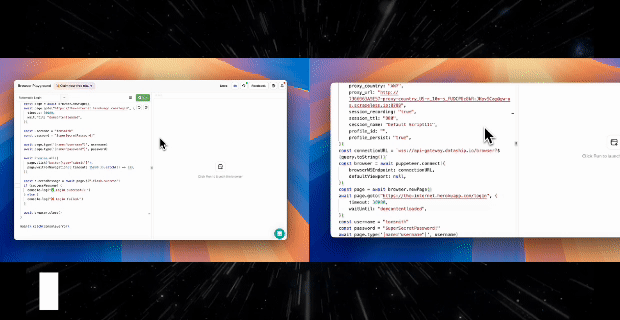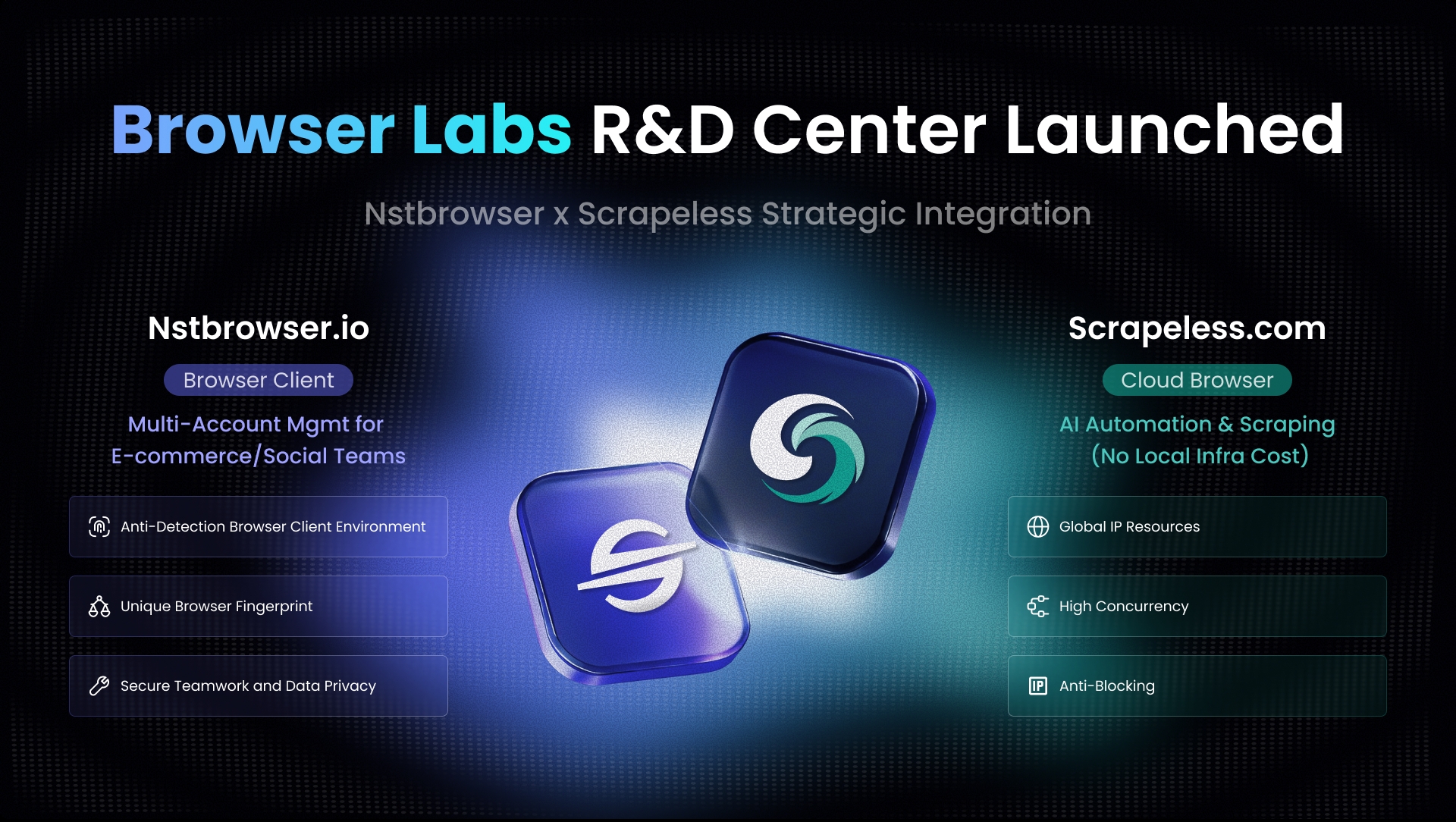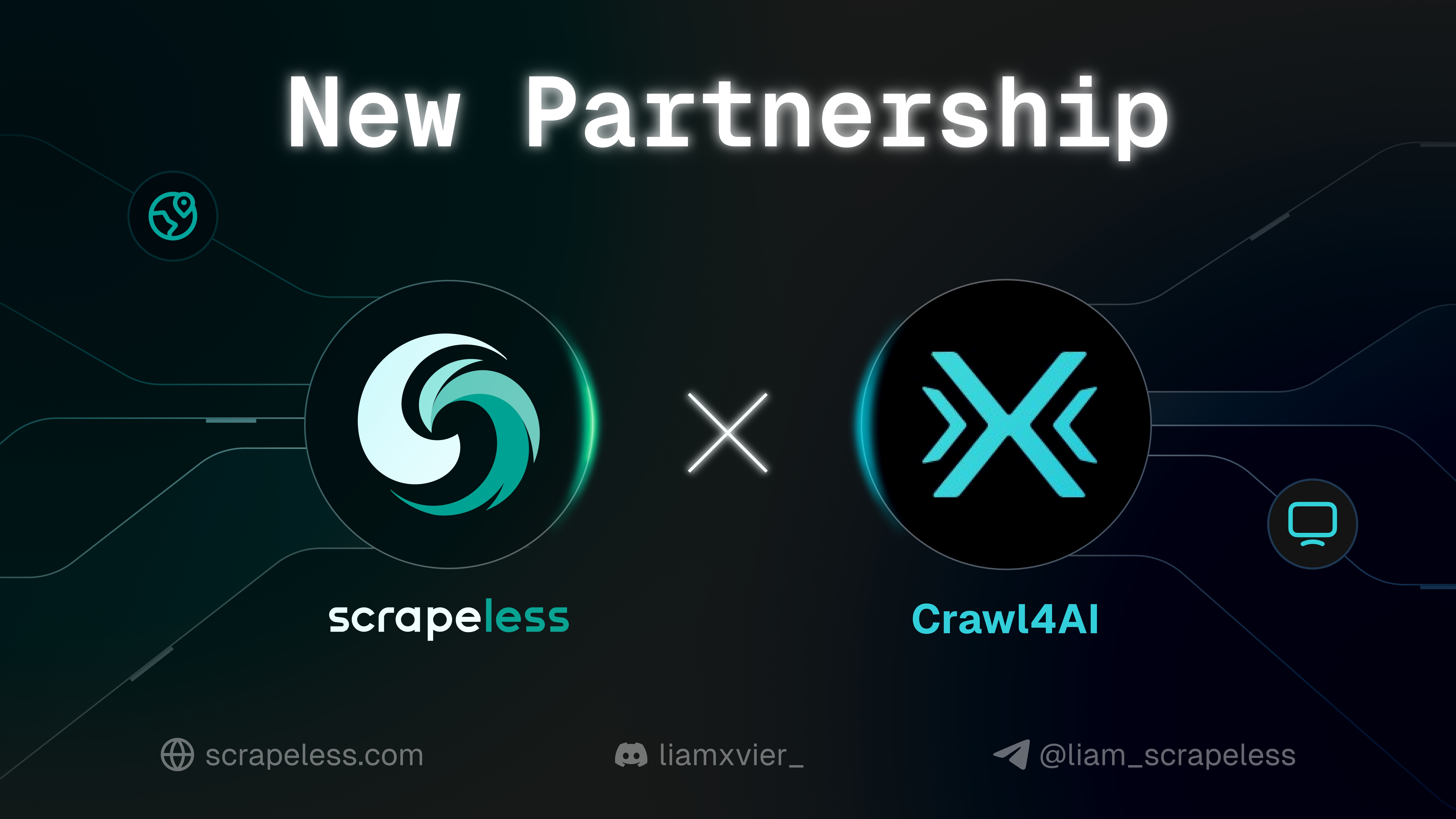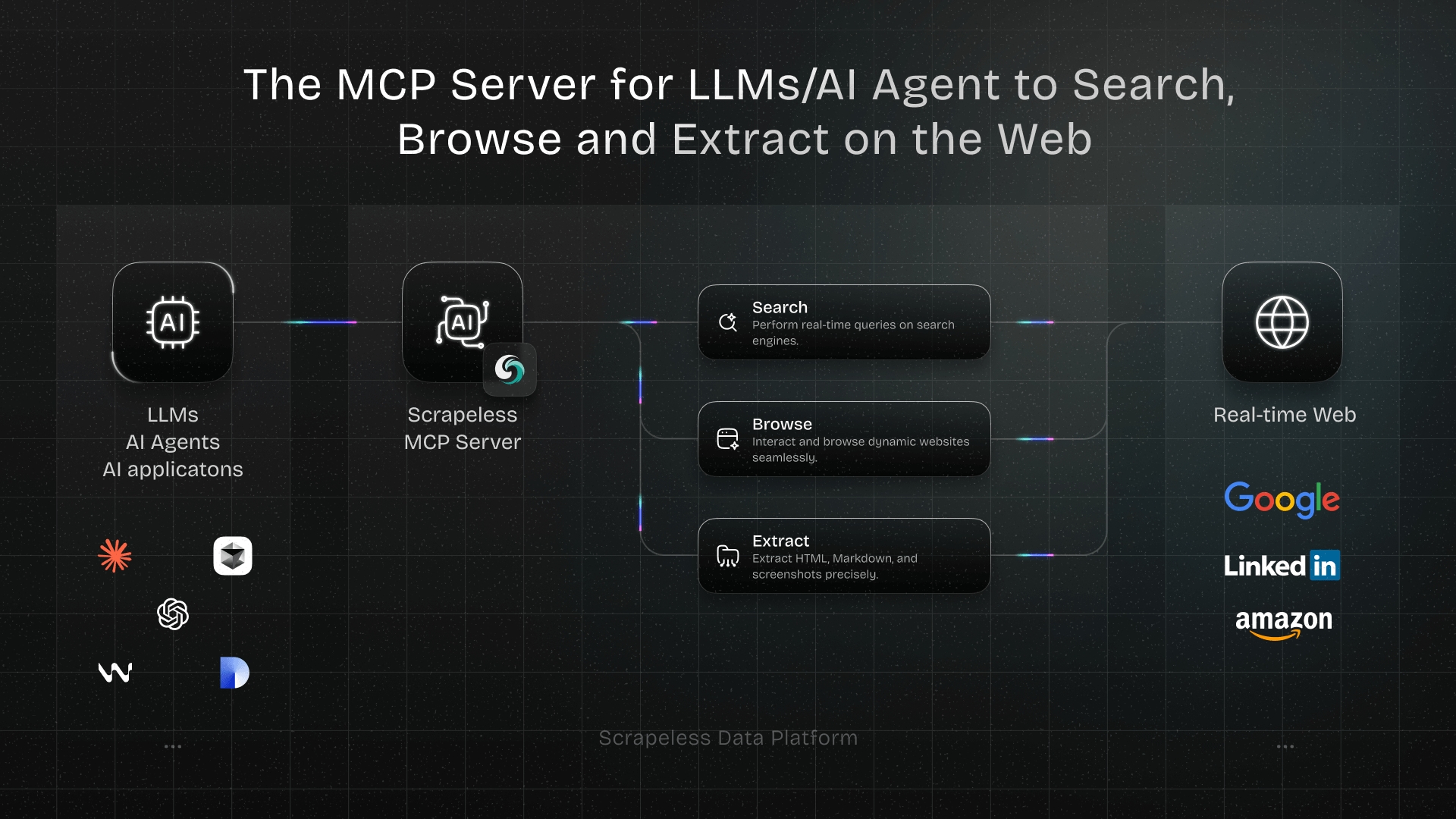Product Updates | New Profile Feature
Advanced Data Extraction Specialist
To enhance the practicality and stability of Scraping Browser in cross-session scenarios, we’ve officially launched the Profile feature for persistent user data. This feature stores browser data (such as cookies, storage, cache, and login states) in the cloud, enabling seamless sharing and reuse across different sessions — eliminating the need to log in repeatedly. It significantly simplifies debugging and improves the efficiency of automation scripts.
Why Introduce Profiles?
In real automated capture or interaction processes, users often need to “remember login status”, “reuse cookies from a particular crawl”, and “synchronize page caches across tasks”. Traditional headless browsers start up in a completely new environment every time and cannot retain any historical context.
The new Profile feature solves this problem by enabling Scraping Browser support:
- Long-term retention of login status, eliminating the need to re-authenticate each time
- Consistent user identity across multiple requests to the same site
- Browser context reuse across sessions during script debugging
Highlights of this Update
Profile Creation and Management Page is Now Live
You can now go to “For Scraping → Profiles” to:
- Create/Edit/Copy/Delete
- View file data size, last used time
- Search target Profile by name or ID
- Copy IDs with one click for scripting or team referencing.
Profile Detail Page: Full Visibility into Configuration and Usage History
Access any Profile to view its complete configuration and usage records, including:
- Basic Information: Profile name, ID, data size, last used time, and total usage count (i.e., how many times it has been used in Sessions);
- Associated Session Records:
-
Live Session List: Real-time sessions currently using this Profile;
-
Session History List: All historical sessions where this Profile was used, with clickable entries for detailed view.
-
This makes the debugging process more transparent and helps reproduce and trace issues more efficiently.
Deep Integration with the Session System
We have also added Profile information display and quick navigation in the following interfaces:
- Live Sessions: Shows the Profile in use (clickable to jump to the Profile detail page)
- Session History: Displays the Profile associated with each session
- Session Detail: Allows you to see which Profile was used during the specific runtime
Functional Demonstration
Case 1: Persistent Login + Improved Loading Speed
Goal: Automatically open pages that require login without entering your username and password every time.
Steps:
1. Configure and save the login state for the first time.
Ways to Create a Profile:
- Manual Creation via Dashboard: Create Profiles manually through the Dashboard.
- API Creation: Automatically create Profiles using the Create Profile API.
- SDK Creation: Create Profiles using the SDK method.
NodeJS
import { Scrapeless } from "@scrapeless-ai/sdk"
const scrapeless = new Scrapeless({
apiKey: "YOUR_API_KEY"
})
// create a new profile
const profile = await scrapeless.profiles.create("scrapeless_profile")
console.log("profile Id:", profile.profileId)Start a session, then specify the profile_id and enable persistence, and manually log in once. The login state (such as cookies and tokens) will be automatically saved to the cloud Profile.
NodeJS
import puppeteer from "puppeteer-core"
import { Scrapeless } from "@scrapeless-ai/sdk"
const scrapeless = new Scrapeless({
apiKey: "YOUR_API_KEY"
});
async function main() {
const proxy= "YOUR_PROXY"
const profileId = "YOUR_PROFILE_ID" // replace with your profileId
const { browserWSEndpoint } = scrapeless.browser.create({
proxy_country: "ANY",
proxy_url: proxy,
session_ttl: "900",
session_name: "Test Profile",
profile_id: profileId,
profile_persist: true,
});
const browser = await puppeteer.connect({
browserWSEndpoint,
defaultViewport: null,
})
const page = await browser.newPage()
await page.goto("https://the-internet.herokuapp.com/login", {
timeout: 30000,
waitUntil: "domcontentloaded",
})
const username = "your username"
const password = "your password!"
await page.type('[name="username"]', username)
await page.type('[name="password"]', password)
await Promise.all([
page.click('button[type="submit"]'),
page.waitForNavigation({ timeout: 15000 }).catch(() => { }),
])
const successMessage = await page.$(".flash.success")
if (successMessage) {
console.log("✅ Login successful!")
} else {
console.log("❌ Login failed.")
}
await browser.close()
}
main().catch(console.error)2. Automatic Reuse of Login Information
- Reuse the same profileId in subsequent scripts or tasks
- Start a new session referencing the previously created profileId, automatically log in to https://the-internet.herokuapp.com/ and open the personal homepage
NodeJS
import puppeteer from "puppeteer-core"
import { Scrapeless } from "@scrapeless-ai/sdk"
const scrapeless = new Scrapeless({
apiKey: "YOUR_API_KEY"
});
async function main() {
const proxy= "YOUR_PROXY"
const profileId = "YOUR_PROFILE_ID" // replace with your profileId
const { browserWSEndpoint } = scrapeless.browser.create({
proxy_country: "ANY",
proxy_url: proxy,
session_ttl: "900",
session_name: "Test Profile",
profile_id: profileId,
profile_persist: true,
});
const browser = await puppeteer.connect({
browserWSEndpoint,
defaultViewport: null,
})
const page = await browser.newPage()
await page.goto("https://the-internet.herokuapp.com/secure", {
timeout: 30000,
waitUntil: "domcontentloaded",
})
const content = await page.content()
console.log("✅ Page content extracted.")
console.log(content)
await browser.close()
}
main().catch(console.error)
Case 2: Automatically Bypass Anti-Bot to Improve Automation Script Success Rate
Goal: In login processes involving anti-bot measures and CAPTCHAs, bypass CAPTCHAs through Profile persistence to reduce interruptions.
Test Site: https://www.leetchi.com/fr/login
Steps:
1. Pass CAPTCHAs and save the state
- Create a new Profile with browser persistence enabled
- Manually log in and complete the human CAPTCHAs (e.g., clicking a CAPTCHA, selecting images, etc.)
- All CAPTCHAs results and login states will be saved to this Profile
NodeJS
import puppeteer from "puppeteer-core"
import { Scrapeless } from "@scrapeless-ai/sdk"
async function main() {
const token = "YOUR_TOKEN"
const proxy = "YOUR_PROXY"
const scrapeless = new Scrapeless({
apiKey: token
})
// create a new profile
const profile = await scrapeless.profiles.create("bot_profile")
// create browser session
const { browserWSEndpoint } = scrapeless.browser.create({
proxy_country: "ANY",
proxy_url: proxy,
session_recording: true,
session_ttl: 900,
session_name: "leetchi_profile",
profile_id: profile.profileId,
profile_persist: true,
})
const browser = await puppeteer.connect({
browserWSEndpoint: browserWSEndpoint,
})
const page = await browser.newPage()
await page.goto("https://www.leetchi.com/fr/login")
await addCaptchaListener(page)
await Promise.all([
page.waitForNavigation(),
page.click('button[data-testid="CookieModal-ConsentAccept-Button"]')
]);
await browser.close()
}
async function addCaptchaListener(page) {
return new Promise(async (resolve) => {
const client = await page.createCDPSession()
client.on("Captcha.detected", (msg) => {
console.log("Captcha.detected:", msg)
})
client.on("Captcha.solveFinished", async (msg) => {
console.log("Captcha.solveFinished:", msg)
resolve(msg)
client.removeAllListeners()
})
})
}2. Reuse Verification Results for Automatic Login
- Start a new session in the script using the same profile_id
- The session will bypass CAPTCHAs and log in automatically without any user action needed
NodeJS
import puppeteer from "puppeteer-core"
import { Scrapeless } from "@scrapeless-ai/sdk"
async function main() {
const token = "YOUR_API_EKY"
const proxy = "YOUR_PROXY"
const profileId = "YOUR_PROFILE_ID"
const scrapeless = new Scrapeless({
apiKey: token
})
const { browserWSEndpoint } = scrapeless.browser.create({
proxy_country: "ANY",
proxy_url: proxy,
session_recording: true,
session_ttl: 900,
session_name: "leetchi_profile_reuse",
profile_id: profileId,
profile_persist: false,
})
const browser = await puppeteer.connect({
browserWSEndpoint: browserWSEndpoint,
})
const page = await browser.newPage()
await page.goto("https://www.leetchi.com/fr/login")
await browser.close()
}
Case 3: Multi-Session Cookie Sharing
Goal: Multiple sessions share a single user identity to perform concurrent operations, such as adding items to a shopping cart.
Use Case: Manage multiple browsers to concurrently access platforms like Amazon and carry out different tasks under the same account.
Steps:
1. Unified Identity Setup
- Create a shared Profile in the console
- Log in to Amazon by entering your username and password, then saving the session data after successful login
NodeJS
import { Scrapeless } from "@scrapeless-ai/sdk"
import puppeteer from "puppeteer-core"
async function loginToAmazonWithSessionProfile() {
const token = "YOUR_API_KEY"; // API Key
const proxy = "YOUR_PROXY"
const amazonAccountEmail = "YOUR_EMAIL"
const amazonAccountPassword = "YOUR_PASSWORD"
const profileName = "amazon";
const scrapeless = new Scrapeless({ apiKey: token });
let profile;
let profileId = "";
// try to get existing profile, or create a new one
const profiles = await scrapeless.profiles.list({
name: profileName,
page: 1,
pageSize: 1,
});
if (profiles?.docs && profiles.docs.length > 0) {
profile = profiles.docs[0];
} else {
profile = await scrapeless.profiles.create(profileName);
}
profileId = profile?.profileId;
if (!profileId) {
return;
}
console.log(profile)
// Build connection URL for Scrapeless browser
const { browserWSEndpoint } = scrapeless.browser.create({
proxy_country: "ANY",
proxy_url: proxy,
session_recording: true,
session_ttl: 900,
session_name: "Login to amazon",
profile_id: profileId, // specific profileId
profile_persist: true, // persist browser data into profile
})
const browser = await puppeteer.connect({
browserWSEndpoint: browserWSEndpoint
})
const page = await browser.newPage();
await page.goto("https://amazon.com", { waitUntil: "networkidle2" });
// Click "Continue shopping" if present
try {
await page.waitForSelector("button.a-button-text", { timeout: 5000 });
await page.evaluate(() => {
const buttons = Array.from(document.querySelectorAll("button.a-button-text"));
const btn = buttons.find(b => b.textContent.trim() === "Continue shopping");
if (btn) btn.click();
});
console.log("clicked 'Continue shopping' button.");
} catch (e) {
console.log("'continue shopping' button not found, continue...");
}
// Click "Sign in" button
await page.waitForSelector("#nav-link-accountList", { timeout: 5000 });
await page.click("#nav-link-accountList");
console.log("clicked 'Sign in' button.");
// Enter email
await page.waitForSelector("#ap_email_login", { timeout: 5000 });
await page.type("#ap_email_login", amazonAccountEmail, { delay: Math.floor(Math.random() * 91) + 10 });
console.log("entered email.");
// Click "Continue"
await page.waitForSelector("#continue-announce", { timeout: 5000 });
await page.click("#continue-announce");
console.log("clicked 'Continue' button.");
// Enter password with random delay per character
await page.waitForSelector("#ap_password", { timeout: 5000 });
for (const char of amazonAccountPassword) {
await page.type("#ap_password", char, { delay: Math.floor(Math.random() * 91) + 10 });
}
console.log("entered password.");
// Click "Sign in" submit button
await page.waitForSelector("#signInSubmit", { timeout: 5000 });
await page.click("#signInSubmit");
console.log("clicked 'Sign in' submit button.");
Optionally: await page.waitForNavigation();
await browser.close();
}
(async () => {
await loginToAmazonWithSessionProfile();
})();2. Concurrent Calls with Consistent Identity
-
Launch multiple sessions (e.g., 3), all referencing the same
profile_id -
All sessions run under the same user identity
-
Perform different page actions separately, such as adding products A, B, and C to the shopping cart
-
Session 1 searches for
shoesand adds them to the cart
import { Scrapeless } from "@scrapeless-ai/sdk"
import puppeteer from "puppeteer-core"
async function addGoodsToCart() {
const token = "YOUR_API_KEY"
const proxy = "YOUR_PROXY"
const profileId = "YOUR_PROFILE_ID"
const search = "shoes"
const scrapeless = new Scrapeless({
apiKey: token
})
// create browser session
const { browserWSEndpoint } = scrapeless.browser.create({
proxy_country: "ANY",
proxy_url: proxy,
session_recording: true,
session_ttl: 900,
session_name: `goods ${search}`,
profile_id: profileId,
profile_persist: false, // disable session persist
})
const client = await puppeteer.connect({
browserWSEndpoint: browserWSEndpoint
})
const page = await client.newPage()
try {
await page.goto("https://www.amazon.com", { waitUntil: "networkidle2" })
await page.waitForSelector('input[id="twotabsearchtextbox"]', { timeout: 5000 })
// Search goods
console.log(`search goods: ${search}`);
await page.type('input[id="twotabsearchtextbox"]', search, { delay: Math.floor(Math.random() * 91) + 10 });
await page.keyboard.press('Enter');
await page.waitForSelector('button[id="a-autoid-3-announce"]', { timeout: 10000 })
// Click goods
await page.click('button[id="a-autoid-3-announce"]')
console.log(`clicked goods`);
await page.waitForSelector('div[id="a-popover-content-2"]', { timeout: 10000 })
await new Promise((resolve) => setTimeout(resolve, 5000))
const buttons = await page.$$('div#a-popover-content-2 button.a-button-text');
if (buttons.length > 0) {
// Click add to cart
await buttons[0].click();
console.log(`clicked add cart`);
}
await client.close();
} catch (e) {
console.log("Adding shopping cart failed.", e);
}
}
(async () => {
await addGoodsToCart()
})()- Session 2 searches for
clothesand adds them to the cart
import { Scrapeless } from "@scrapeless-ai/sdk"
import puppeteer from "puppeteer-core"
async function addGoodsToCart() {
const token = "YOUR_API_KEY"
const proxy = "YOUR_PROXY"
const profileId = "YOUR_PROFILE_ID"
const search = "clothes"
const scrapeless = new Scrapeless({
apiKey: token
})
// create browser session
const { browserWSEndpoint } = scrapeless.browser.create({
proxy_country: "ANY",
proxy_url: proxy,
session_recording: true,
session_ttl: 900,
session_name: `goods ${search}`,
profile_id: profileId,
profile_persist: false, // disable session persist
})
const client = await puppeteer.connect({
browserWSEndpoint: browserWSEndpoint
})
const page = await client.newPage()
try {
await page.goto("https://www.amazon.com", { waitUntil: "networkidle2" })
await page.waitForSelector('input[id="twotabsearchtextbox"]', { timeout: 5000 })
// Search goods
console.log(`search goods: ${search}`);
await page.type('input[id="twotabsearchtextbox"]', search, { delay: Math.floor(Math.random() * 91) + 10 });
await page.keyboard.press('Enter');
await page.waitForSelector('button[id="a-autoid-3-announce"]', { timeout: 10000 })
// Click goods
await page.click('button[id="a-autoid-3-announce"]')
console.log(`clicked goods`);
await page.waitForSelector('div[id="a-popover-content-2"]', { timeout: 10000 })
await new Promise((resolve) => setTimeout(resolve, 5000))
const buttons = await page.$$('div#a-popover-content-2 button.a-button-text');
if (buttons.length > 0) {
// Click add to cart
await buttons[0].click();
console.log(`clicked add cart`);
}
await client.close();
} catch (e) {
console.log("Adding shopping cart failed.", e);
}
}
(async () => {
await addGoodsToCart()
})()- Session 3 searches for
pantsand adds them to the cart
import { Scrapeless } from "@scrapeless-ai/sdk"
import puppeteer from "puppeteer-core"
async function addGoodsToCart() {
const token = "YOUR_API_KEY"
const proxy = "YOUR_PROXY"
const profileId = "YOUR_PROFILE_ID"
const search = "pants"
const scrapeless = new Scrapeless({
apiKey: token
})
// create browser session
const { browserWSEndpoint } = scrapeless.browser.create({
proxy_country: "ANY",
proxy_url: proxy,
session_recording: true,
session_ttl: 900,
session_name: `goods ${search}`,
profile_id: profileId,
profile_persist: false, // disable session persist
})
const client = await puppeteer.connect({
browserWSEndpoint: browserWSEndpoint
})
const page = await client.newPage()
try {
await page.goto("https://www.amazon.com", { waitUntil: "networkidle2" })
await page.waitForSelector('input[id="twotabsearchtextbox"]', { timeout: 5000 })
// Search goods
console.log(`search goods: ${search}`);
await page.type('input[id="twotabsearchtextbox"]', search, { delay: Math.floor(Math.random() * 91) + 10 });
await page.keyboard.press('Enter');
await page.waitForSelector('button[id="a-autoid-3-announce"]', { timeout: 10000 })
// Click goods
await page.click('button[id="a-autoid-3-announce"]')
console.log(`clicked goods`);
await page.waitForSelector('div[id="a-popover-content-2"]', { timeout: 10000 })
await new Promise((resolve) => setTimeout(resolve, 5000))
const buttons = await page.$$('div#a-popover-content-2 button.a-button-text');
if (buttons.length > 0) {
// Click add to cart
await buttons[0].click();
console.log(`clicked add cart`);
}
await client.close();
} catch (e) {
console.log("Adding shopping cart failed.", e);
}
}
(async () => {
await addGoodsToCart()
})()
Which Scenarios Are These Features Suitable For?
The launch of Profiles significantly enhances Scraping Browser’s performance in multi-user, multi-session, and complex workflow environments. Below are typical practical use cases:
Automated Data Collection / Crawling Projects
When frequently scraping websites that require login (such as e-commerce, recruitment, or social media platforms):
- Persist login states to avoid frequent risk control triggers;
- Retain key contexts like cookies, storage, and tokens;
- Assign different identities (Profiles) for different tasks to manage account pools or identity pools.
Team Collaboration / Multi-Environment Configuration Management
Within development, testing, and operations teams:
- Each member maintains their own Profile configuration without interference;
- Profile IDs can be directly embedded in automation scripts to ensure consistent calls;
- Supports custom naming and bulk cleanup to keep environments clean and organized.
QA / Customer Support / Online Issue Reproduction
- QA can preset Profiles associated with key test cases, avoiding state reconstruction during playback;
- Customer support scenarios can restore customers’ operating environments via Profiles for accurate issue reproduction;
- All sessions can link to Profile usage records, facilitating troubleshooting of context-related issues.
👉 Open the Playground and experience it now.
At Scrapeless, we only access publicly available data while strictly complying with applicable laws, regulations, and website privacy policies. The content in this blog is for demonstration purposes only and does not involve any illegal or infringing activities. We make no guarantees and disclaim all liability for the use of information from this blog or third-party links. Before engaging in any scraping activities, consult your legal advisor and review the target website's terms of service or obtain the necessary permissions.



